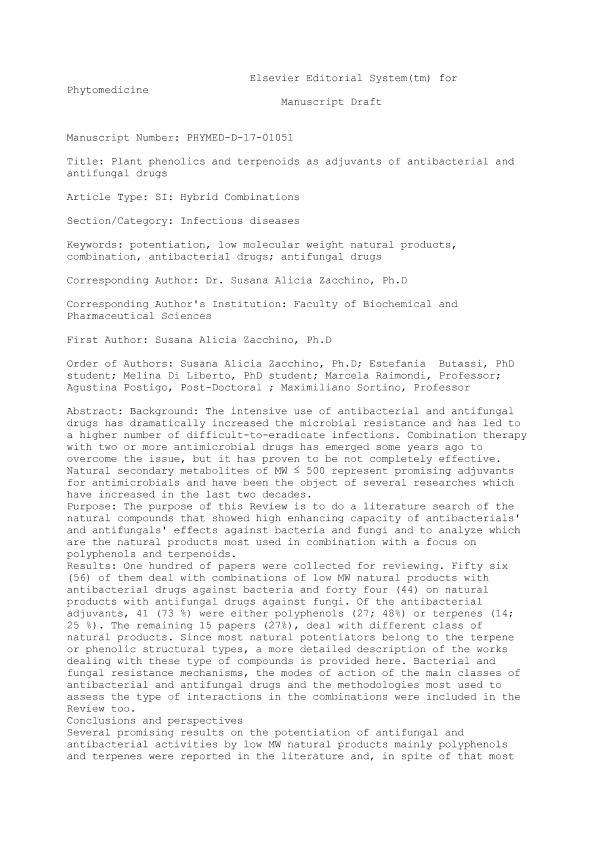Artículo
Plant phenolics and terpenoids as adjuvants of antibacterial and antifungal drugs
Zacchino, Susana Alicia Stella; Butassi, Estefanía ; Di Liberto, Melina Gabriela
; Di Liberto, Melina Gabriela ; Raimondi, Marcela; Postigo, Agustina
; Raimondi, Marcela; Postigo, Agustina ; Sortino, Maximiliano Andrés
; Sortino, Maximiliano Andrés
 ; Di Liberto, Melina Gabriela
; Di Liberto, Melina Gabriela ; Raimondi, Marcela; Postigo, Agustina
; Raimondi, Marcela; Postigo, Agustina ; Sortino, Maximiliano Andrés
; Sortino, Maximiliano Andrés
Fecha de publicación:
12/2017
Editorial:
Elsevier Gmbh
Revista:
Phytomedicine
ISSN:
0944-7113
Idioma:
Inglés
Tipo de recurso:
Artículo publicado
Clasificación temática:
Resumen
Background The intensive use of antibacterial and antifungal drugs has dramatically increased the microbial resistance and has led to a higher number of difficult-to-eradicate infections. Combination therapy with two or more antimicrobial drugs has emerged some years ago to overcome the issue, but it has proven to be not completely effective. Natural secondary metabolites of MW ≤ 500 represent promising adjuvants for antimicrobials and have been the object of several researches that have increased in the last two decades. Purpose The purpose of this Review is to do a literature search of the natural compounds that showed high enhancing capacity of antibacterials’ and antifungals’ effects against planktonic bacteria and fungi and to analyze which are the natural products most used in combination with a focus on polyphenols and terpenoids. Results One hundred of papers were collected for reviewing. Fifty six (56) of them deal with combinations of low MW natural products with antibacterial drugs against planktonic bacteria and forty four (44) on natural products with antifungal drugs against planktonic fungi. Of the antibacterial adjuvants, 41 (73%) were either polyphenols (27; 48%) or terpenes (14; 25%). The remaining 15 papers (27%), deal with different class of natural products. Since most natural potentiators belong to the terpene or phenolic structural types, a more detailed description of the works dealing with these type of compounds is provided here. Bacterial and fungal resistance mechanisms, the modes of action of the main classes of antibacterial and antifungal drugs and the methodologies most used to assess the type of interactions in the combinations were included in the Review too. Conclusions and perspectives Several promising results on the potentiation effects of antifungals’ and antibacterials’ activities by low MW natural products mainly on polyphenols and terpenes were reported in the literature and, in spite of that most works included only in vitro assays, this knowledge opens a wide range of possibilities for the combination antimicrobial therapy. Further research including in vivo assays and clinical trials are required to determine the relevance of these antimicrobial enhancers in the clinical area and should be the focus of future studies in order to develop new antimicrobial combination agents that overpass the drawbacks of the existing antibiotics and antifungals in clinical use.
Archivos asociados
Licencia
Identificadores
Colecciones
Articulos(CCT - ROSARIO)
Articulos de CTRO.CIENTIFICO TECNOL.CONICET - ROSARIO
Articulos de CTRO.CIENTIFICO TECNOL.CONICET - ROSARIO
Articulos(CEFOBI)
Articulos de CENTRO DE EST.FOTOSINTETICOS Y BIOQUIMICOS (I)
Articulos de CENTRO DE EST.FOTOSINTETICOS Y BIOQUIMICOS (I)
Citación
Zacchino, Susana Alicia Stella; Butassi, Estefanía; Di Liberto, Melina Gabriela; Raimondi, Marcela; Postigo, Agustina; et al.; Plant phenolics and terpenoids as adjuvants of antibacterial and antifungal drugs; Elsevier Gmbh; Phytomedicine; 37; 12-2017; 27-48
Compartir
Altmétricas



